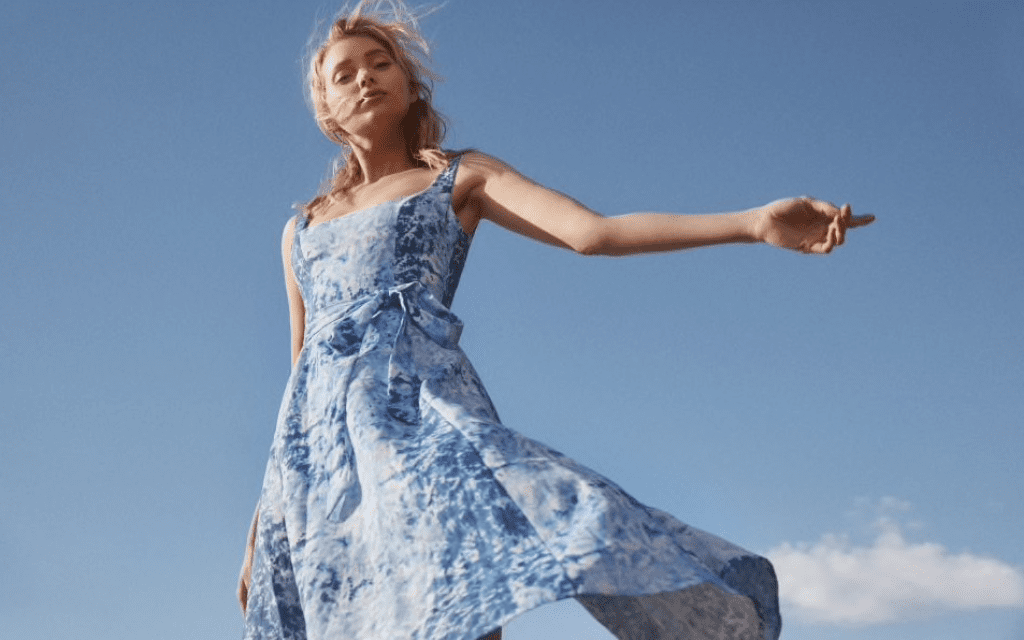Sustainable fashion-centric searches by consumers in the U.S. are up by about 15 percent compared to this time last year, Lyst asserts in a newly-release report. Teaming up with Good on You, an organization that aims to help shoppers make better purchasing decisions, Lyst identifies how much fashion’s focus on sustainability is actually impacting consumer search and shopping behavior by pairing its own search metrics with Google search data, and global media coverage and social media mentioned generated between February 2019 and February 2020.
In terms of searches on its own fashion discovery platform, Lyst revealed that searches for “vegan leather,” “organic cotton,” and “recycled plastic” are up, with demand for adidas’ various recycled plastic sneakers, for instance, seeing a 305 percent increase in page views and Nanushka’s vegan leather puffer jacket being the most searched for product on its site among U.S. consumers in February 2020.
In the U.S., in particular, vegan shoes – including Veja’s Campo sneakers, which have been the most-wanted non-leather product on Lyst for the past year, and whose searches for which are “are currently up 115 percent year-on-year – are top performers. Meanwhile, in the U.K, dresses by Reformation, Faithfull the Brand and Maggie Marilyn are “the most searched for sustainable products.” Sustainable denim tops the lists of searches for consumers in Denmark; sustainable “denim, swimwear and sportswear” are of primary interest for Australian consumers; and “eco-friendly parkas and sneakers” are what German consumers are seeking out. In France, the most searched-for terms are “vegan Dr. Martens boots,” followed by “vegan Veja sneakers” and “faux leather trousers,” while Canadian customers are particularly interested in parkas and jeans when “shopping for environmentally-friendly fashion.”
What do these search trends mean for the future? A rep for Good on You told Lyst that fashion industry “innovators are already redesigning business models with sustainable principles like circularity in mind,” with the understanding that “the current throwaway culture in fashion is inherently unsustainable and needs to change.” More than that, the most forward-thinking brands when it comes to sustainability, such as Patagonia, are “educating customers on how to care for, reuse and recycle their clothes over the long run,” something that Good on You expects will shape the fashion industry going forward.
Most brands are “talking about sustainability with their customers, and publishing more information about their practices and promoting sustainable collections,” and those that are not doing so “run the risk of losing market share,” the company asserts.
As for whether these spikes in interest in sustainability-centric products mean that consumers are shying away from fast fashion en masse, it seems unlikely as of now. The September 2019 bankruptcy of Forever 21, for instance, paired with other hints of upheaval in the fast fashion sector had many questioning whether the model of high-turnover of low cost, trend-specific apparel and accessories is falling out of fashion in favor of sustainability. However, the enduring success of digitally-native fast fashion entities, such as Fashion Nova, Boohoo, Missguided, and PrettyLittleThing, among others, is telling.
These newer online fast fashion retailers are proving to be significantly more apt than their predecessors at giving teens and young adults what they want in terms of the garments, themselves, but also when it comes to frequency of new merchandise and broader ranges in sizing. In fact, retailers like Fashion Nova and Missguided have “enjoyed such huge growth as a result of targeting young shoppers,” as the Guardian asserted this spring. These millennial and Gen-Z consumers “prefer to buy clothes on their phone and increasingly take their fashion advice from social media influencers and celebrities, not Vogue,” which has enabled newer names to set themselves apart from older entities like Forever 21.
As such, the success of these younger, more Gen-Z-focused companies is almost certainly coming at the expense of cheap-fashion pioneers like Zara, Forever 21, and H&M, which does not signal the downfall of cheap, disposable fashion. It more clearly suggests that there are other market entities that are beating these first-movers at their own game. All the while, any rise in sustainable fashion is not necessarily being reflected in most fast fashion brands’ bottom lines. As of early this year, Boohoo, for instance, revealed that it was on track to surpass profit and revenue forecasts for the year after it reported overall sales for the fourth quarter that soared by 44 per cent year-on-year to more than $582 million.
At the same time, even the old guard (aside from bankrupt Forever 21) is starting to faring well again. Before the onset of COVID-19, H&M revealed that its revenue increased by 6 percent for the 2019 financial year, compared to revenue growth of 3 percent revenue for the previous year. As the Wall Street Journal reported in January, the growth was significant, as the Swedish giant, which maintains the title of the world’s second-biggest fashion retailer, had struggled in recent years due to the fact that it was “slower to react to changes in shopping habits than its larger Spanish rival Zara,” whose parent company Inditex reported a net profit of $1.3 billion for the third quarter of 2019 and forecasted full-year sales growth of up to 6 percent.
Questions do, however, remain as to whether the steadfast devotion of consumers to the multi-billion dollar fast fashion industry will continue seemingly unabated; in a November 2019 report, McKinsey noted that “while the absolute number of sustainable fashion products remains low, there has been a fivefold increase over the past two years,” and predicted that revenue growth will slow for fast fashion giants as sustainability continues to be an important initiative for brands and a growing pool of consumers, alike.











